Project: Employee Turnover Impact on Australian Bank Performance
VerifiedAdded on 2020/04/15
|14
|2988
|42
Project
AI Summary
This project investigates the relationship between employee performance, customer satisfaction, and organizational performance within the Australian banking industry, focusing on Commonwealth Bank, Macquarie Bank, and ANZ Bank. It examines factors like employee benefits, training, and trust, using financial ratios such as return on assets (ROA), return on equity (ROE), employee turnover ratio, and profitability margin to analyze the correlation. The study finds a positive correlation between employee turnover and profitability, although not always significant, with Commonwealth Bank showing the strongest influence. The research employs secondary data analysis of annual reports from 2012 to 2016 to assess these relationships and their impact on bank performance. Desklib offers similar projects and solved assignments for students.

Running head: PROFESSIONAL PROJECT
Professional Project
Name of the Student:
Name of the University:
Author Note
Professional Project
Name of the Student:
Name of the University:
Author Note
Paraphrase This Document
Need a fresh take? Get an instant paraphrase of this document with our AI Paraphraser
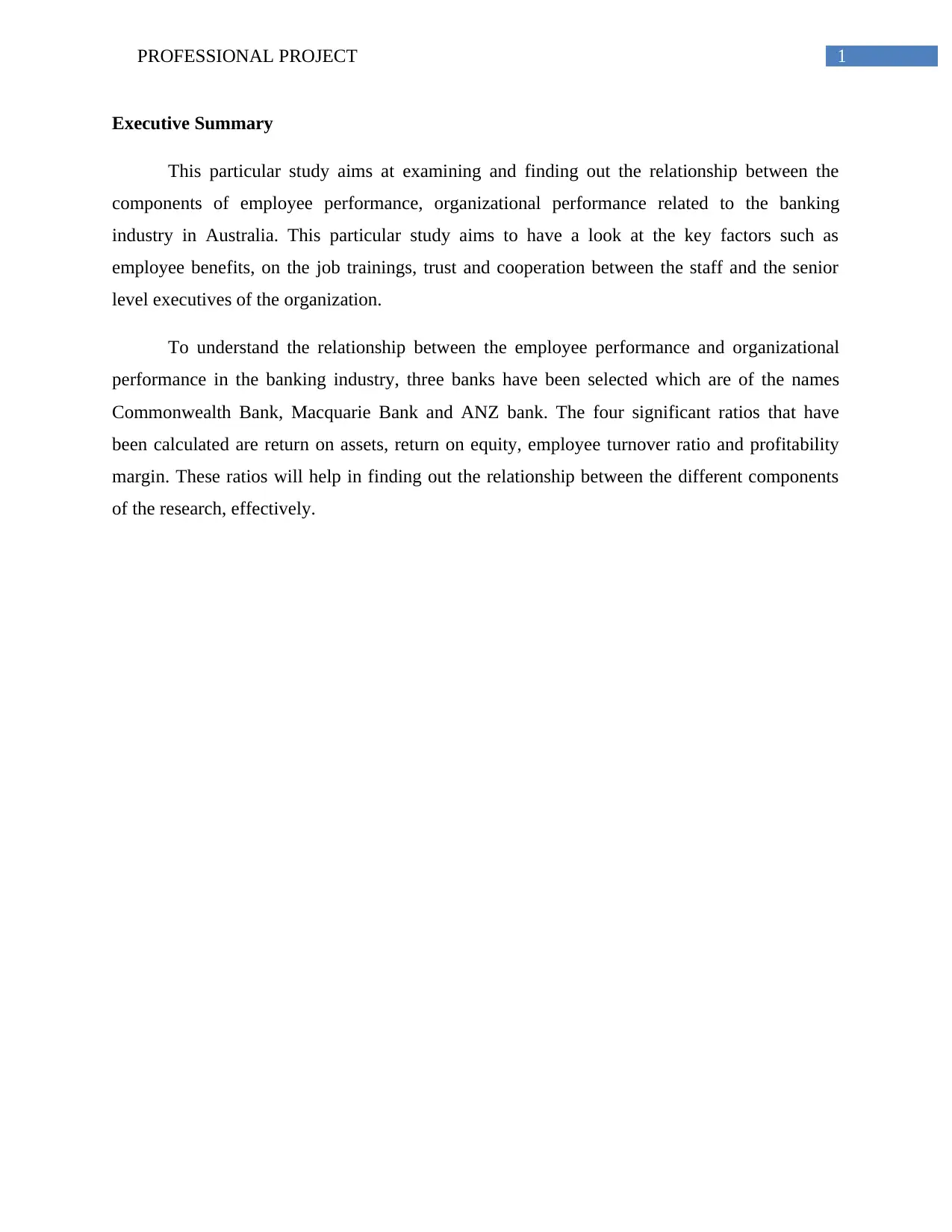
1PROFESSIONAL PROJECT
Executive Summary
This particular study aims at examining and finding out the relationship between the
components of employee performance, organizational performance related to the banking
industry in Australia. This particular study aims to have a look at the key factors such as
employee benefits, on the job trainings, trust and cooperation between the staff and the senior
level executives of the organization.
To understand the relationship between the employee performance and organizational
performance in the banking industry, three banks have been selected which are of the names
Commonwealth Bank, Macquarie Bank and ANZ bank. The four significant ratios that have
been calculated are return on assets, return on equity, employee turnover ratio and profitability
margin. These ratios will help in finding out the relationship between the different components
of the research, effectively.
Executive Summary
This particular study aims at examining and finding out the relationship between the
components of employee performance, organizational performance related to the banking
industry in Australia. This particular study aims to have a look at the key factors such as
employee benefits, on the job trainings, trust and cooperation between the staff and the senior
level executives of the organization.
To understand the relationship between the employee performance and organizational
performance in the banking industry, three banks have been selected which are of the names
Commonwealth Bank, Macquarie Bank and ANZ bank. The four significant ratios that have
been calculated are return on assets, return on equity, employee turnover ratio and profitability
margin. These ratios will help in finding out the relationship between the different components
of the research, effectively.

2PROFESSIONAL PROJECT
Table of Contents
Introduction......................................................................................................................................3
Problem Statement.......................................................................................................................3
Research aim and research questions..........................................................................................3
Research Question.......................................................................................................................4
Literature Review............................................................................................................................4
Methodology....................................................................................................................................5
Data Collection............................................................................................................................6
Data Analysis...............................................................................................................................6
Findings and analysis.......................................................................................................................6
Correlation...................................................................................................................................6
Regression....................................................................................................................................8
Discussion........................................................................................................................................9
Conclusion.....................................................................................................................................10
Table of Contents
Introduction......................................................................................................................................3
Problem Statement.......................................................................................................................3
Research aim and research questions..........................................................................................3
Research Question.......................................................................................................................4
Literature Review............................................................................................................................4
Methodology....................................................................................................................................5
Data Collection............................................................................................................................6
Data Analysis...............................................................................................................................6
Findings and analysis.......................................................................................................................6
Correlation...................................................................................................................................6
Regression....................................................................................................................................8
Discussion........................................................................................................................................9
Conclusion.....................................................................................................................................10
⊘ This is a preview!⊘
Do you want full access?
Subscribe today to unlock all pages.

Trusted by 1+ million students worldwide
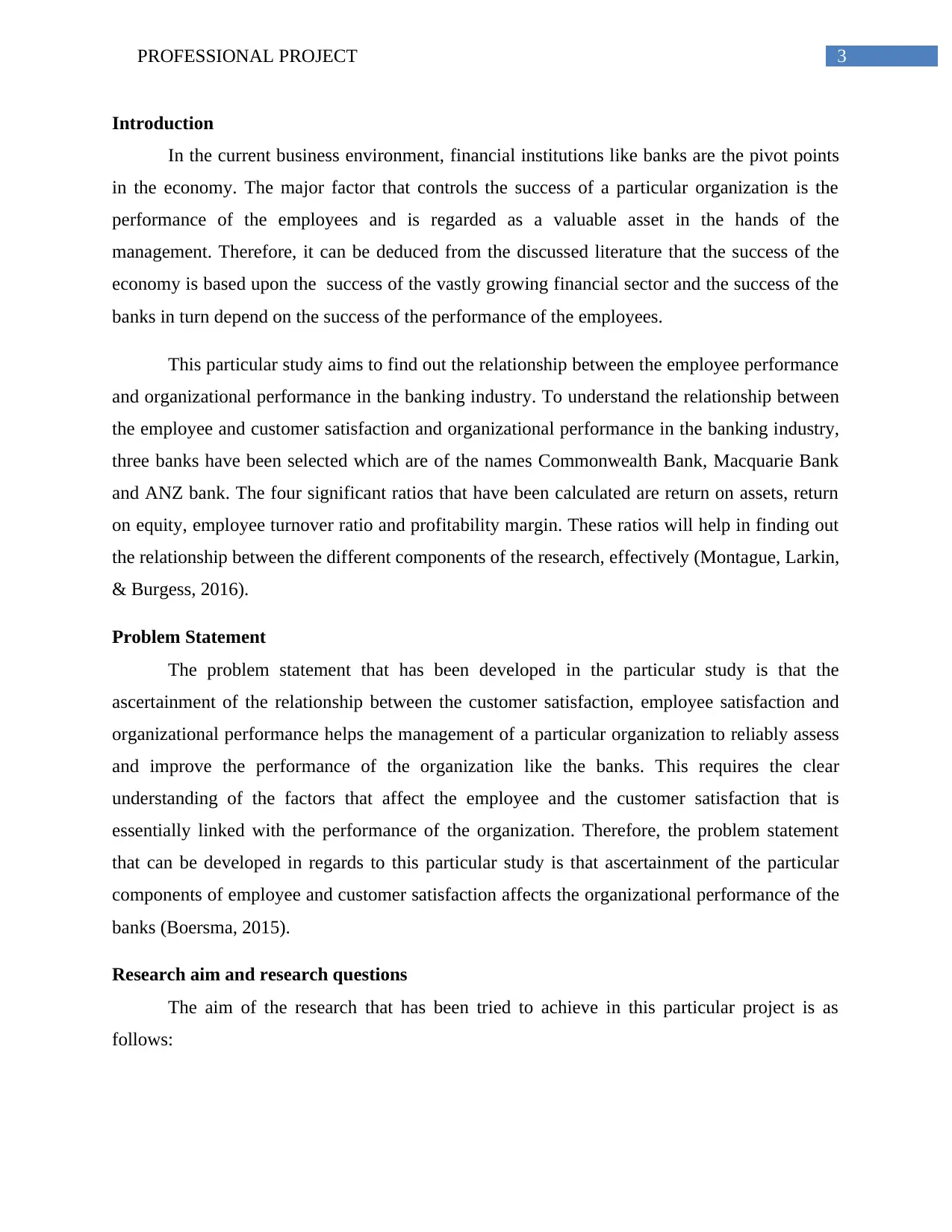
3PROFESSIONAL PROJECT
Introduction
In the current business environment, financial institutions like banks are the pivot points
in the economy. The major factor that controls the success of a particular organization is the
performance of the employees and is regarded as a valuable asset in the hands of the
management. Therefore, it can be deduced from the discussed literature that the success of the
economy is based upon the success of the vastly growing financial sector and the success of the
banks in turn depend on the success of the performance of the employees.
This particular study aims to find out the relationship between the employee performance
and organizational performance in the banking industry. To understand the relationship between
the employee and customer satisfaction and organizational performance in the banking industry,
three banks have been selected which are of the names Commonwealth Bank, Macquarie Bank
and ANZ bank. The four significant ratios that have been calculated are return on assets, return
on equity, employee turnover ratio and profitability margin. These ratios will help in finding out
the relationship between the different components of the research, effectively (Montague, Larkin,
& Burgess, 2016).
Problem Statement
The problem statement that has been developed in the particular study is that the
ascertainment of the relationship between the customer satisfaction, employee satisfaction and
organizational performance helps the management of a particular organization to reliably assess
and improve the performance of the organization like the banks. This requires the clear
understanding of the factors that affect the employee and the customer satisfaction that is
essentially linked with the performance of the organization. Therefore, the problem statement
that can be developed in regards to this particular study is that ascertainment of the particular
components of employee and customer satisfaction affects the organizational performance of the
banks (Boersma, 2015).
Research aim and research questions
The aim of the research that has been tried to achieve in this particular project is as
follows:
Introduction
In the current business environment, financial institutions like banks are the pivot points
in the economy. The major factor that controls the success of a particular organization is the
performance of the employees and is regarded as a valuable asset in the hands of the
management. Therefore, it can be deduced from the discussed literature that the success of the
economy is based upon the success of the vastly growing financial sector and the success of the
banks in turn depend on the success of the performance of the employees.
This particular study aims to find out the relationship between the employee performance
and organizational performance in the banking industry. To understand the relationship between
the employee and customer satisfaction and organizational performance in the banking industry,
three banks have been selected which are of the names Commonwealth Bank, Macquarie Bank
and ANZ bank. The four significant ratios that have been calculated are return on assets, return
on equity, employee turnover ratio and profitability margin. These ratios will help in finding out
the relationship between the different components of the research, effectively (Montague, Larkin,
& Burgess, 2016).
Problem Statement
The problem statement that has been developed in the particular study is that the
ascertainment of the relationship between the customer satisfaction, employee satisfaction and
organizational performance helps the management of a particular organization to reliably assess
and improve the performance of the organization like the banks. This requires the clear
understanding of the factors that affect the employee and the customer satisfaction that is
essentially linked with the performance of the organization. Therefore, the problem statement
that can be developed in regards to this particular study is that ascertainment of the particular
components of employee and customer satisfaction affects the organizational performance of the
banks (Boersma, 2015).
Research aim and research questions
The aim of the research that has been tried to achieve in this particular project is as
follows:
Paraphrase This Document
Need a fresh take? Get an instant paraphrase of this document with our AI Paraphraser
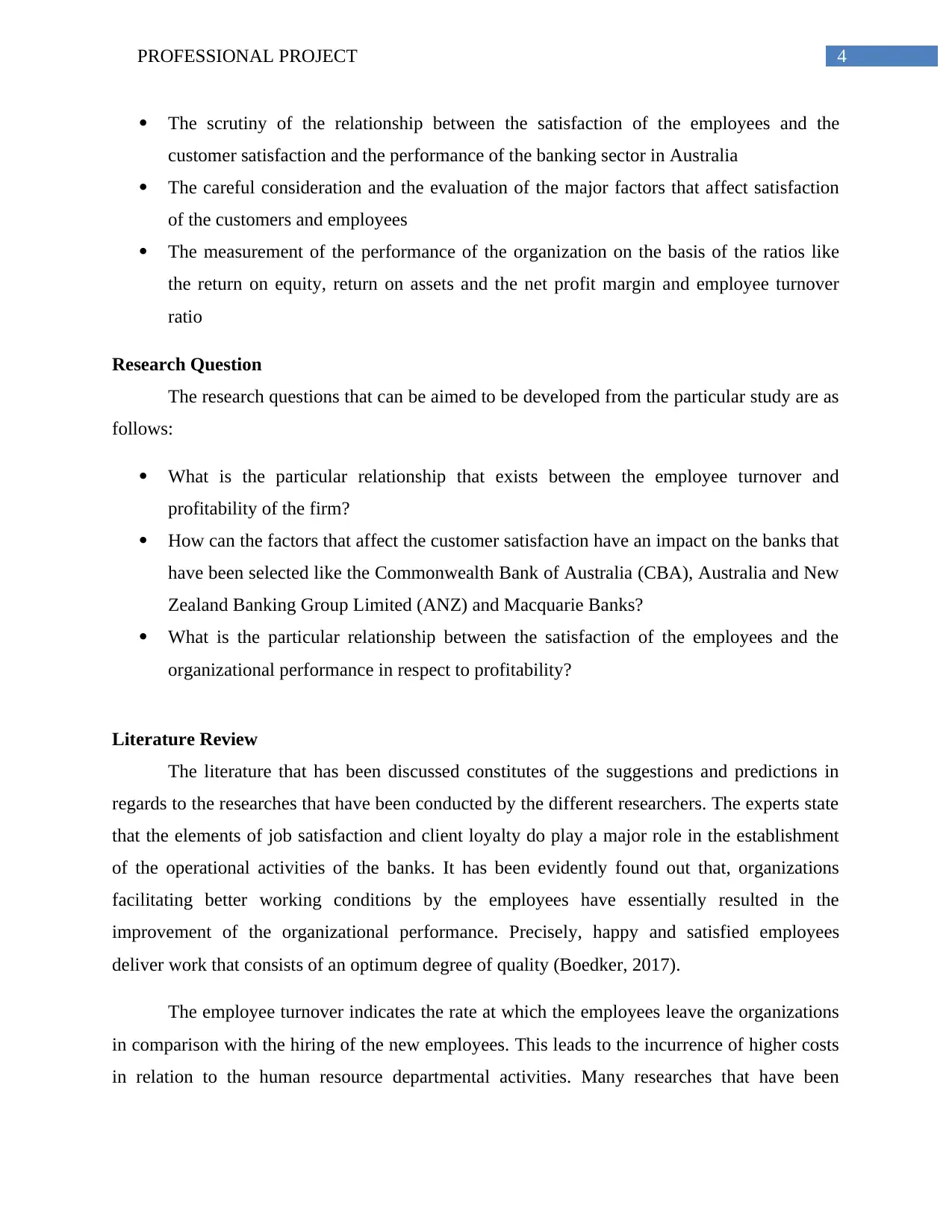
4PROFESSIONAL PROJECT
The scrutiny of the relationship between the satisfaction of the employees and the
customer satisfaction and the performance of the banking sector in Australia
The careful consideration and the evaluation of the major factors that affect satisfaction
of the customers and employees
The measurement of the performance of the organization on the basis of the ratios like
the return on equity, return on assets and the net profit margin and employee turnover
ratio
Research Question
The research questions that can be aimed to be developed from the particular study are as
follows:
What is the particular relationship that exists between the employee turnover and
profitability of the firm?
How can the factors that affect the customer satisfaction have an impact on the banks that
have been selected like the Commonwealth Bank of Australia (CBA), Australia and New
Zealand Banking Group Limited (ANZ) and Macquarie Banks?
What is the particular relationship between the satisfaction of the employees and the
organizational performance in respect to profitability?
Literature Review
The literature that has been discussed constitutes of the suggestions and predictions in
regards to the researches that have been conducted by the different researchers. The experts state
that the elements of job satisfaction and client loyalty do play a major role in the establishment
of the operational activities of the banks. It has been evidently found out that, organizations
facilitating better working conditions by the employees have essentially resulted in the
improvement of the organizational performance. Precisely, happy and satisfied employees
deliver work that consists of an optimum degree of quality (Boedker, 2017).
The employee turnover indicates the rate at which the employees leave the organizations
in comparison with the hiring of the new employees. This leads to the incurrence of higher costs
in relation to the human resource departmental activities. Many researches that have been
The scrutiny of the relationship between the satisfaction of the employees and the
customer satisfaction and the performance of the banking sector in Australia
The careful consideration and the evaluation of the major factors that affect satisfaction
of the customers and employees
The measurement of the performance of the organization on the basis of the ratios like
the return on equity, return on assets and the net profit margin and employee turnover
ratio
Research Question
The research questions that can be aimed to be developed from the particular study are as
follows:
What is the particular relationship that exists between the employee turnover and
profitability of the firm?
How can the factors that affect the customer satisfaction have an impact on the banks that
have been selected like the Commonwealth Bank of Australia (CBA), Australia and New
Zealand Banking Group Limited (ANZ) and Macquarie Banks?
What is the particular relationship between the satisfaction of the employees and the
organizational performance in respect to profitability?
Literature Review
The literature that has been discussed constitutes of the suggestions and predictions in
regards to the researches that have been conducted by the different researchers. The experts state
that the elements of job satisfaction and client loyalty do play a major role in the establishment
of the operational activities of the banks. It has been evidently found out that, organizations
facilitating better working conditions by the employees have essentially resulted in the
improvement of the organizational performance. Precisely, happy and satisfied employees
deliver work that consists of an optimum degree of quality (Boedker, 2017).
The employee turnover indicates the rate at which the employees leave the organizations
in comparison with the hiring of the new employees. This leads to the incurrence of higher costs
in relation to the human resource departmental activities. Many researches that have been
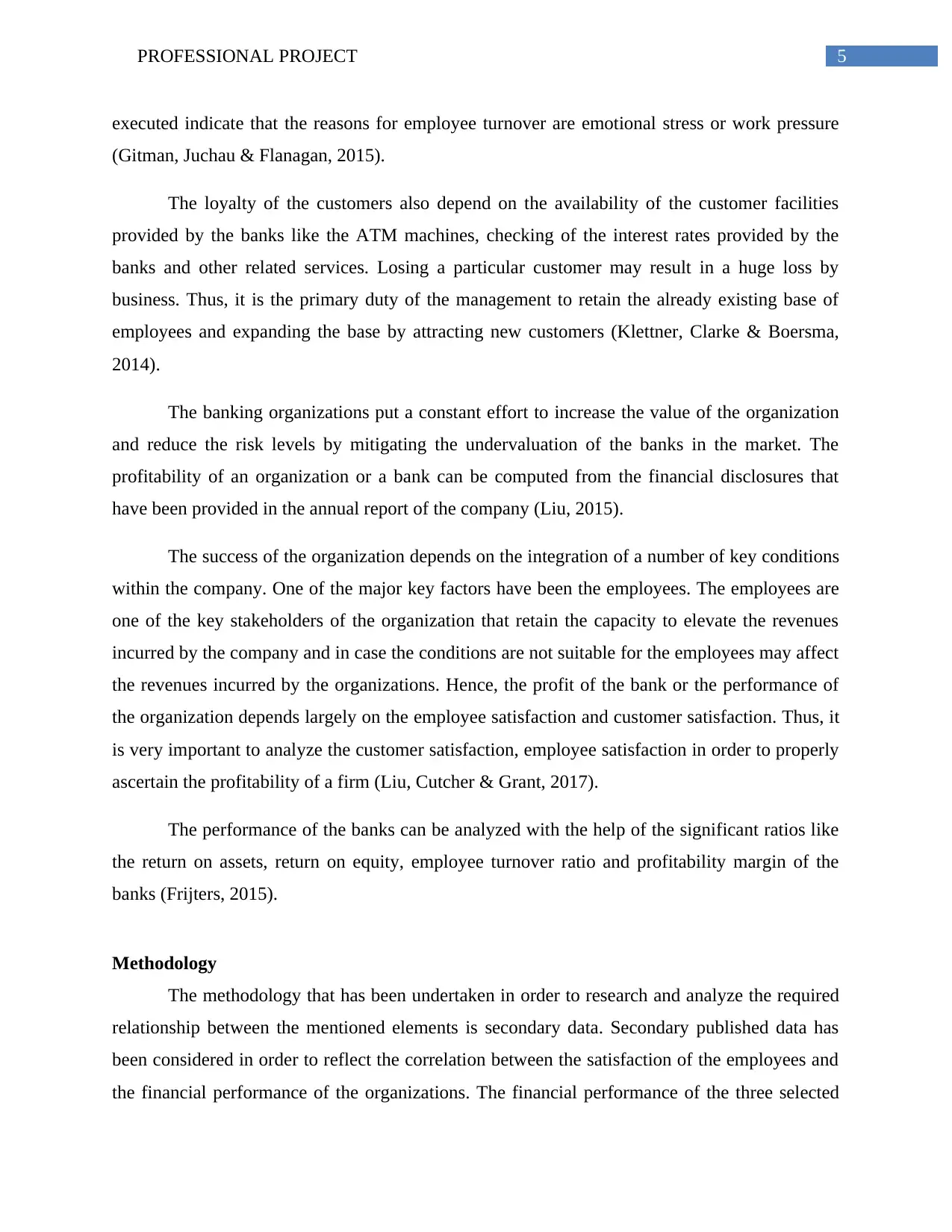
5PROFESSIONAL PROJECT
executed indicate that the reasons for employee turnover are emotional stress or work pressure
(Gitman, Juchau & Flanagan, 2015).
The loyalty of the customers also depend on the availability of the customer facilities
provided by the banks like the ATM machines, checking of the interest rates provided by the
banks and other related services. Losing a particular customer may result in a huge loss by
business. Thus, it is the primary duty of the management to retain the already existing base of
employees and expanding the base by attracting new customers (Klettner, Clarke & Boersma,
2014).
The banking organizations put a constant effort to increase the value of the organization
and reduce the risk levels by mitigating the undervaluation of the banks in the market. The
profitability of an organization or a bank can be computed from the financial disclosures that
have been provided in the annual report of the company (Liu, 2015).
The success of the organization depends on the integration of a number of key conditions
within the company. One of the major key factors have been the employees. The employees are
one of the key stakeholders of the organization that retain the capacity to elevate the revenues
incurred by the company and in case the conditions are not suitable for the employees may affect
the revenues incurred by the organizations. Hence, the profit of the bank or the performance of
the organization depends largely on the employee satisfaction and customer satisfaction. Thus, it
is very important to analyze the customer satisfaction, employee satisfaction in order to properly
ascertain the profitability of a firm (Liu, Cutcher & Grant, 2017).
The performance of the banks can be analyzed with the help of the significant ratios like
the return on assets, return on equity, employee turnover ratio and profitability margin of the
banks (Frijters, 2015).
Methodology
The methodology that has been undertaken in order to research and analyze the required
relationship between the mentioned elements is secondary data. Secondary published data has
been considered in order to reflect the correlation between the satisfaction of the employees and
the financial performance of the organizations. The financial performance of the three selected
executed indicate that the reasons for employee turnover are emotional stress or work pressure
(Gitman, Juchau & Flanagan, 2015).
The loyalty of the customers also depend on the availability of the customer facilities
provided by the banks like the ATM machines, checking of the interest rates provided by the
banks and other related services. Losing a particular customer may result in a huge loss by
business. Thus, it is the primary duty of the management to retain the already existing base of
employees and expanding the base by attracting new customers (Klettner, Clarke & Boersma,
2014).
The banking organizations put a constant effort to increase the value of the organization
and reduce the risk levels by mitigating the undervaluation of the banks in the market. The
profitability of an organization or a bank can be computed from the financial disclosures that
have been provided in the annual report of the company (Liu, 2015).
The success of the organization depends on the integration of a number of key conditions
within the company. One of the major key factors have been the employees. The employees are
one of the key stakeholders of the organization that retain the capacity to elevate the revenues
incurred by the company and in case the conditions are not suitable for the employees may affect
the revenues incurred by the organizations. Hence, the profit of the bank or the performance of
the organization depends largely on the employee satisfaction and customer satisfaction. Thus, it
is very important to analyze the customer satisfaction, employee satisfaction in order to properly
ascertain the profitability of a firm (Liu, Cutcher & Grant, 2017).
The performance of the banks can be analyzed with the help of the significant ratios like
the return on assets, return on equity, employee turnover ratio and profitability margin of the
banks (Frijters, 2015).
Methodology
The methodology that has been undertaken in order to research and analyze the required
relationship between the mentioned elements is secondary data. Secondary published data has
been considered in order to reflect the correlation between the satisfaction of the employees and
the financial performance of the organizations. The financial performance of the three selected
⊘ This is a preview!⊘
Do you want full access?
Subscribe today to unlock all pages.

Trusted by 1+ million students worldwide
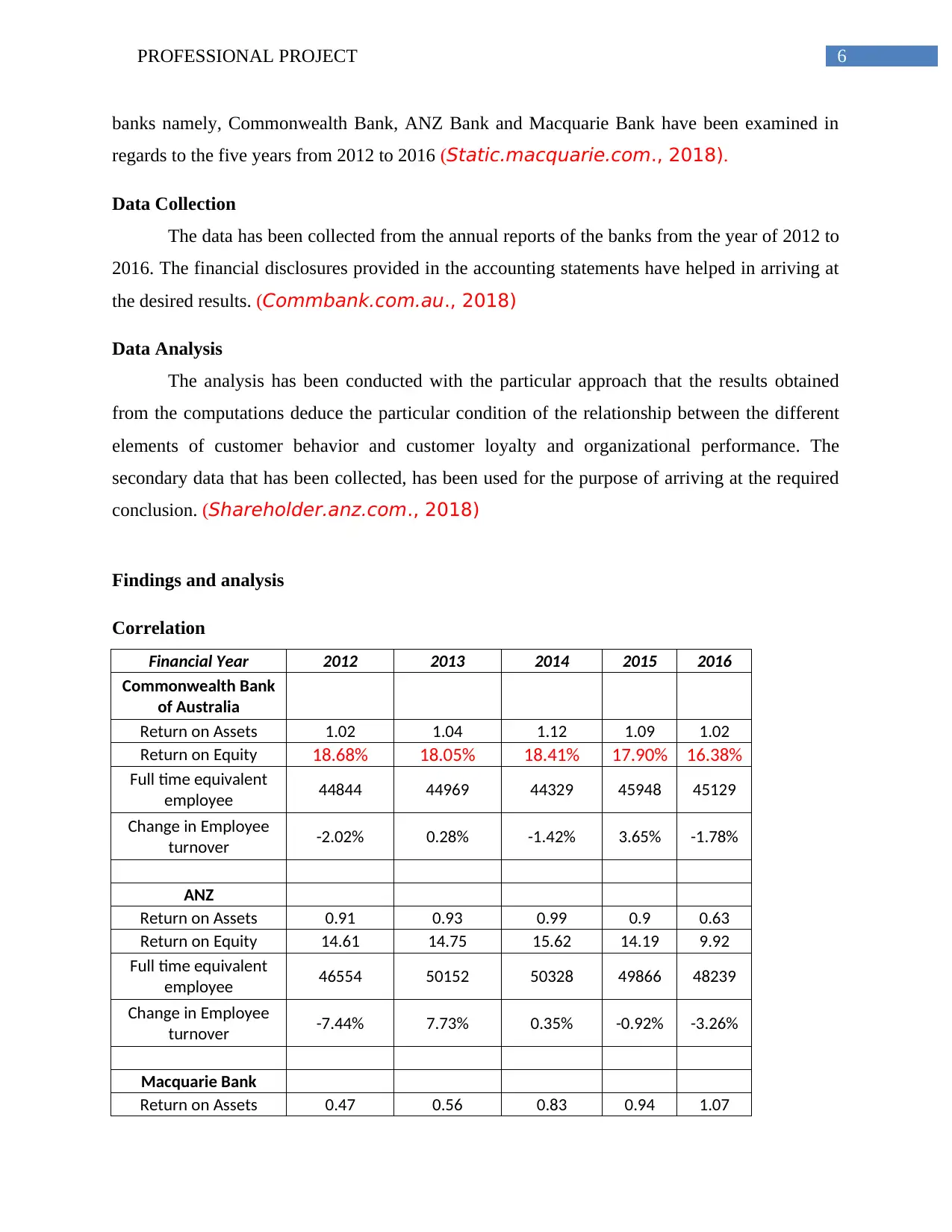
6PROFESSIONAL PROJECT
banks namely, Commonwealth Bank, ANZ Bank and Macquarie Bank have been examined in
regards to the five years from 2012 to 2016 (Static.macquarie.com., 2018).
Data Collection
The data has been collected from the annual reports of the banks from the year of 2012 to
2016. The financial disclosures provided in the accounting statements have helped in arriving at
the desired results. (Commbank.com.au., 2018)
Data Analysis
The analysis has been conducted with the particular approach that the results obtained
from the computations deduce the particular condition of the relationship between the different
elements of customer behavior and customer loyalty and organizational performance. The
secondary data that has been collected, has been used for the purpose of arriving at the required
conclusion. (Shareholder.anz.com., 2018)
Findings and analysis
Correlation
Financial Year 2012 2013 2014 2015 2016
Commonwealth Bank
of Australia
Return on Assets 1.02 1.04 1.12 1.09 1.02
Return on Equity 18.68% 18.05% 18.41% 17.90% 16.38%
Full time equivalent
employee 44844 44969 44329 45948 45129
Change in Employee
turnover -2.02% 0.28% -1.42% 3.65% -1.78%
ANZ
Return on Assets 0.91 0.93 0.99 0.9 0.63
Return on Equity 14.61 14.75 15.62 14.19 9.92
Full time equivalent
employee 46554 50152 50328 49866 48239
Change in Employee
turnover -7.44% 7.73% 0.35% -0.92% -3.26%
Macquarie Bank
Return on Assets 0.47 0.56 0.83 0.94 1.07
banks namely, Commonwealth Bank, ANZ Bank and Macquarie Bank have been examined in
regards to the five years from 2012 to 2016 (Static.macquarie.com., 2018).
Data Collection
The data has been collected from the annual reports of the banks from the year of 2012 to
2016. The financial disclosures provided in the accounting statements have helped in arriving at
the desired results. (Commbank.com.au., 2018)
Data Analysis
The analysis has been conducted with the particular approach that the results obtained
from the computations deduce the particular condition of the relationship between the different
elements of customer behavior and customer loyalty and organizational performance. The
secondary data that has been collected, has been used for the purpose of arriving at the required
conclusion. (Shareholder.anz.com., 2018)
Findings and analysis
Correlation
Financial Year 2012 2013 2014 2015 2016
Commonwealth Bank
of Australia
Return on Assets 1.02 1.04 1.12 1.09 1.02
Return on Equity 18.68% 18.05% 18.41% 17.90% 16.38%
Full time equivalent
employee 44844 44969 44329 45948 45129
Change in Employee
turnover -2.02% 0.28% -1.42% 3.65% -1.78%
ANZ
Return on Assets 0.91 0.93 0.99 0.9 0.63
Return on Equity 14.61 14.75 15.62 14.19 9.92
Full time equivalent
employee 46554 50152 50328 49866 48239
Change in Employee
turnover -7.44% 7.73% 0.35% -0.92% -3.26%
Macquarie Bank
Return on Assets 0.47 0.56 0.83 0.94 1.07
Paraphrase This Document
Need a fresh take? Get an instant paraphrase of this document with our AI Paraphraser
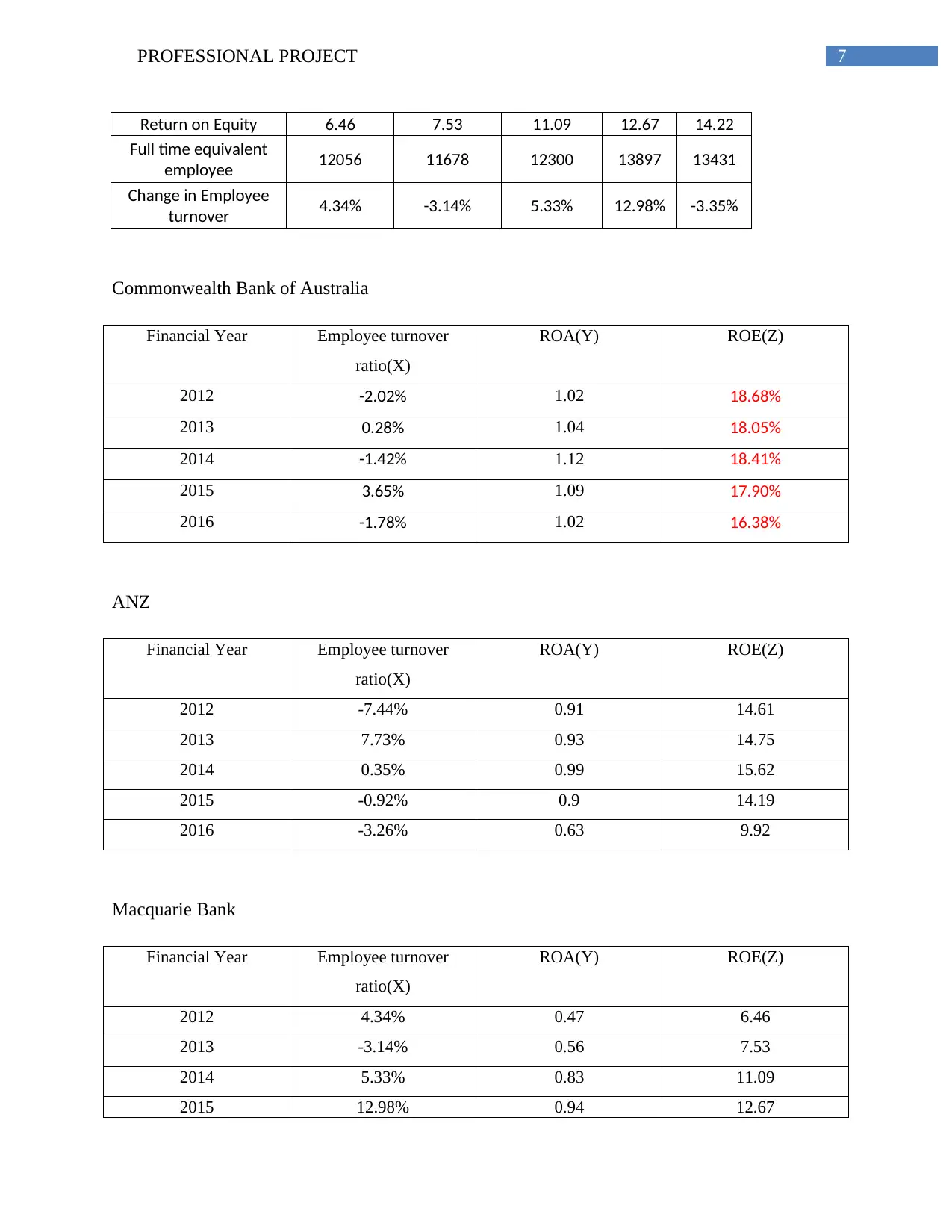
7PROFESSIONAL PROJECT
Return on Equity 6.46 7.53 11.09 12.67 14.22
Full time equivalent
employee 12056 11678 12300 13897 13431
Change in Employee
turnover 4.34% -3.14% 5.33% 12.98% -3.35%
Commonwealth Bank of Australia
Financial Year Employee turnover
ratio(X)
ROA(Y) ROE(Z)
2012 -2.02% 1.02 18.68%
2013 0.28% 1.04 18.05%
2014 -1.42% 1.12 18.41%
2015 3.65% 1.09 17.90%
2016 -1.78% 1.02 16.38%
ANZ
Financial Year Employee turnover
ratio(X)
ROA(Y) ROE(Z)
2012 -7.44% 0.91 14.61
2013 7.73% 0.93 14.75
2014 0.35% 0.99 15.62
2015 -0.92% 0.9 14.19
2016 -3.26% 0.63 9.92
Macquarie Bank
Financial Year Employee turnover
ratio(X)
ROA(Y) ROE(Z)
2012 4.34% 0.47 6.46
2013 -3.14% 0.56 7.53
2014 5.33% 0.83 11.09
2015 12.98% 0.94 12.67
Return on Equity 6.46 7.53 11.09 12.67 14.22
Full time equivalent
employee 12056 11678 12300 13897 13431
Change in Employee
turnover 4.34% -3.14% 5.33% 12.98% -3.35%
Commonwealth Bank of Australia
Financial Year Employee turnover
ratio(X)
ROA(Y) ROE(Z)
2012 -2.02% 1.02 18.68%
2013 0.28% 1.04 18.05%
2014 -1.42% 1.12 18.41%
2015 3.65% 1.09 17.90%
2016 -1.78% 1.02 16.38%
ANZ
Financial Year Employee turnover
ratio(X)
ROA(Y) ROE(Z)
2012 -7.44% 0.91 14.61
2013 7.73% 0.93 14.75
2014 0.35% 0.99 15.62
2015 -0.92% 0.9 14.19
2016 -3.26% 0.63 9.92
Macquarie Bank
Financial Year Employee turnover
ratio(X)
ROA(Y) ROE(Z)
2012 4.34% 0.47 6.46
2013 -3.14% 0.56 7.53
2014 5.33% 0.83 11.09
2015 12.98% 0.94 12.67
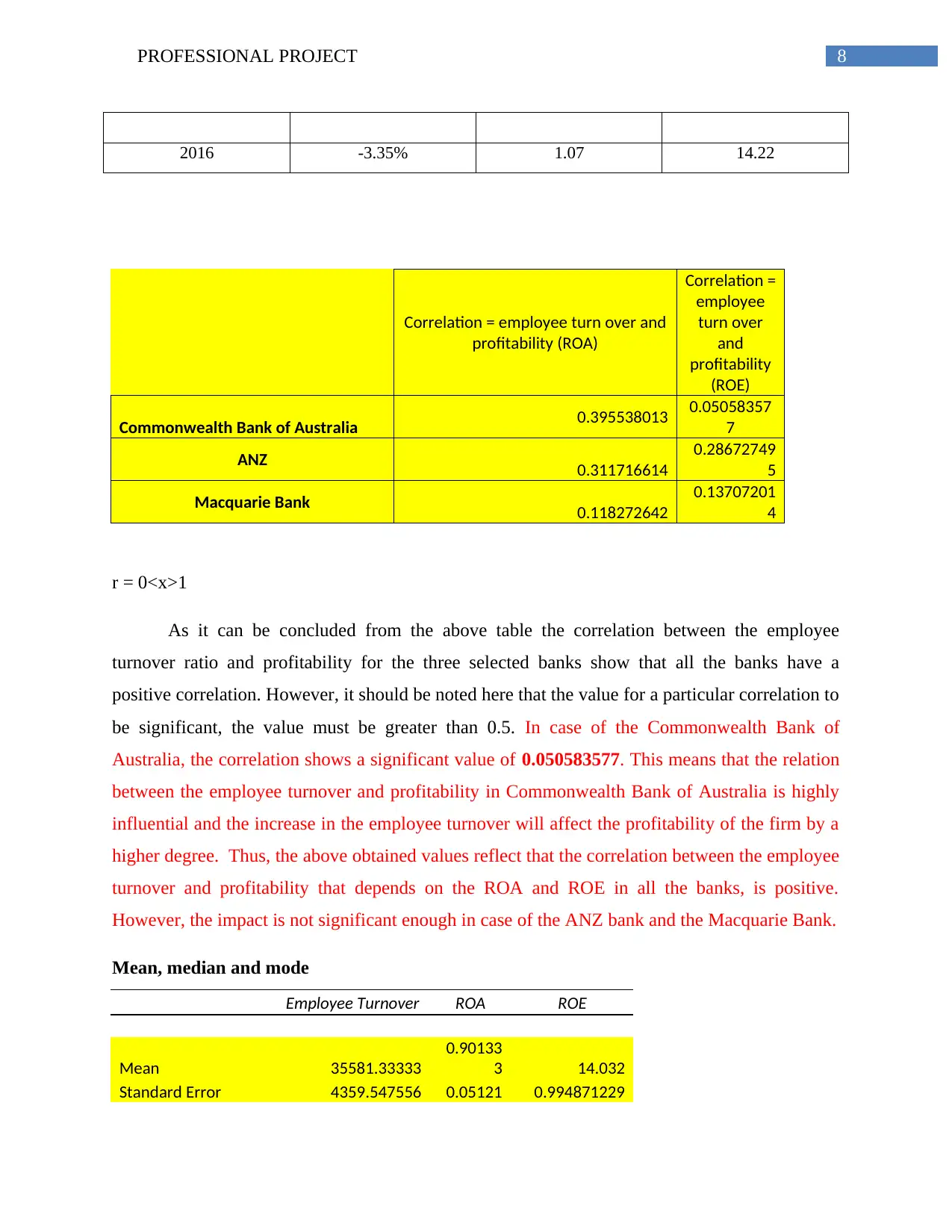
8PROFESSIONAL PROJECT
2016 -3.35% 1.07 14.22
Correlation = employee turn over and
profitability (ROA)
Correlation =
employee
turn over
and
profitability
(ROE)
Commonwealth Bank of Australia 0.395538013 0.05058357
7
ANZ 0.311716614
0.28672749
5
Macquarie Bank 0.118272642
0.13707201
4
r = 0<x>1
As it can be concluded from the above table the correlation between the employee
turnover ratio and profitability for the three selected banks show that all the banks have a
positive correlation. However, it should be noted here that the value for a particular correlation to
be significant, the value must be greater than 0.5. In case of the Commonwealth Bank of
Australia, the correlation shows a significant value of 0.050583577. This means that the relation
between the employee turnover and profitability in Commonwealth Bank of Australia is highly
influential and the increase in the employee turnover will affect the profitability of the firm by a
higher degree. Thus, the above obtained values reflect that the correlation between the employee
turnover and profitability that depends on the ROA and ROE in all the banks, is positive.
However, the impact is not significant enough in case of the ANZ bank and the Macquarie Bank.
Mean, median and mode
Employee Turnover ROA ROE
Mean 35581.33333
0.90133
3 14.032
Standard Error 4359.547556 0.05121 0.994871229
2016 -3.35% 1.07 14.22
Correlation = employee turn over and
profitability (ROA)
Correlation =
employee
turn over
and
profitability
(ROE)
Commonwealth Bank of Australia 0.395538013 0.05058357
7
ANZ 0.311716614
0.28672749
5
Macquarie Bank 0.118272642
0.13707201
4
r = 0<x>1
As it can be concluded from the above table the correlation between the employee
turnover ratio and profitability for the three selected banks show that all the banks have a
positive correlation. However, it should be noted here that the value for a particular correlation to
be significant, the value must be greater than 0.5. In case of the Commonwealth Bank of
Australia, the correlation shows a significant value of 0.050583577. This means that the relation
between the employee turnover and profitability in Commonwealth Bank of Australia is highly
influential and the increase in the employee turnover will affect the profitability of the firm by a
higher degree. Thus, the above obtained values reflect that the correlation between the employee
turnover and profitability that depends on the ROA and ROE in all the banks, is positive.
However, the impact is not significant enough in case of the ANZ bank and the Macquarie Bank.
Mean, median and mode
Employee Turnover ROA ROE
Mean 35581.33333
0.90133
3 14.032
Standard Error 4359.547556 0.05121 0.994871229
⊘ This is a preview!⊘
Do you want full access?
Subscribe today to unlock all pages.

Trusted by 1+ million students worldwide
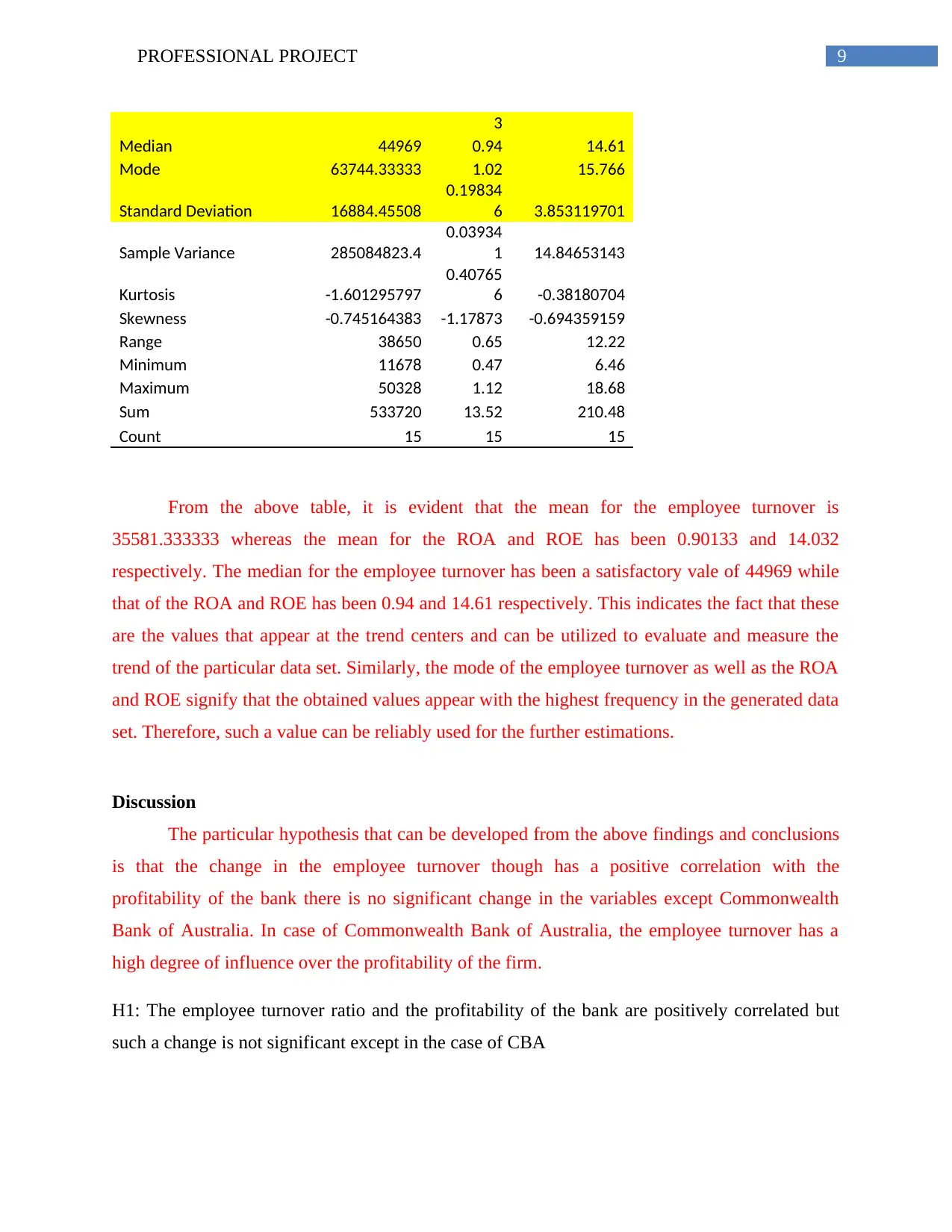
9PROFESSIONAL PROJECT
3
Median 44969 0.94 14.61
Mode 63744.33333 1.02 15.766
Standard Deviation 16884.45508
0.19834
6 3.853119701
Sample Variance 285084823.4
0.03934
1 14.84653143
Kurtosis -1.601295797
0.40765
6 -0.38180704
Skewness -0.745164383 -1.17873 -0.694359159
Range 38650 0.65 12.22
Minimum 11678 0.47 6.46
Maximum 50328 1.12 18.68
Sum 533720 13.52 210.48
Count 15 15 15
From the above table, it is evident that the mean for the employee turnover is
35581.333333 whereas the mean for the ROA and ROE has been 0.90133 and 14.032
respectively. The median for the employee turnover has been a satisfactory vale of 44969 while
that of the ROA and ROE has been 0.94 and 14.61 respectively. This indicates the fact that these
are the values that appear at the trend centers and can be utilized to evaluate and measure the
trend of the particular data set. Similarly, the mode of the employee turnover as well as the ROA
and ROE signify that the obtained values appear with the highest frequency in the generated data
set. Therefore, such a value can be reliably used for the further estimations.
Discussion
The particular hypothesis that can be developed from the above findings and conclusions
is that the change in the employee turnover though has a positive correlation with the
profitability of the bank there is no significant change in the variables except Commonwealth
Bank of Australia. In case of Commonwealth Bank of Australia, the employee turnover has a
high degree of influence over the profitability of the firm.
H1: The employee turnover ratio and the profitability of the bank are positively correlated but
such a change is not significant except in the case of CBA
3
Median 44969 0.94 14.61
Mode 63744.33333 1.02 15.766
Standard Deviation 16884.45508
0.19834
6 3.853119701
Sample Variance 285084823.4
0.03934
1 14.84653143
Kurtosis -1.601295797
0.40765
6 -0.38180704
Skewness -0.745164383 -1.17873 -0.694359159
Range 38650 0.65 12.22
Minimum 11678 0.47 6.46
Maximum 50328 1.12 18.68
Sum 533720 13.52 210.48
Count 15 15 15
From the above table, it is evident that the mean for the employee turnover is
35581.333333 whereas the mean for the ROA and ROE has been 0.90133 and 14.032
respectively. The median for the employee turnover has been a satisfactory vale of 44969 while
that of the ROA and ROE has been 0.94 and 14.61 respectively. This indicates the fact that these
are the values that appear at the trend centers and can be utilized to evaluate and measure the
trend of the particular data set. Similarly, the mode of the employee turnover as well as the ROA
and ROE signify that the obtained values appear with the highest frequency in the generated data
set. Therefore, such a value can be reliably used for the further estimations.
Discussion
The particular hypothesis that can be developed from the above findings and conclusions
is that the change in the employee turnover though has a positive correlation with the
profitability of the bank there is no significant change in the variables except Commonwealth
Bank of Australia. In case of Commonwealth Bank of Australia, the employee turnover has a
high degree of influence over the profitability of the firm.
H1: The employee turnover ratio and the profitability of the bank are positively correlated but
such a change is not significant except in the case of CBA
Paraphrase This Document
Need a fresh take? Get an instant paraphrase of this document with our AI Paraphraser
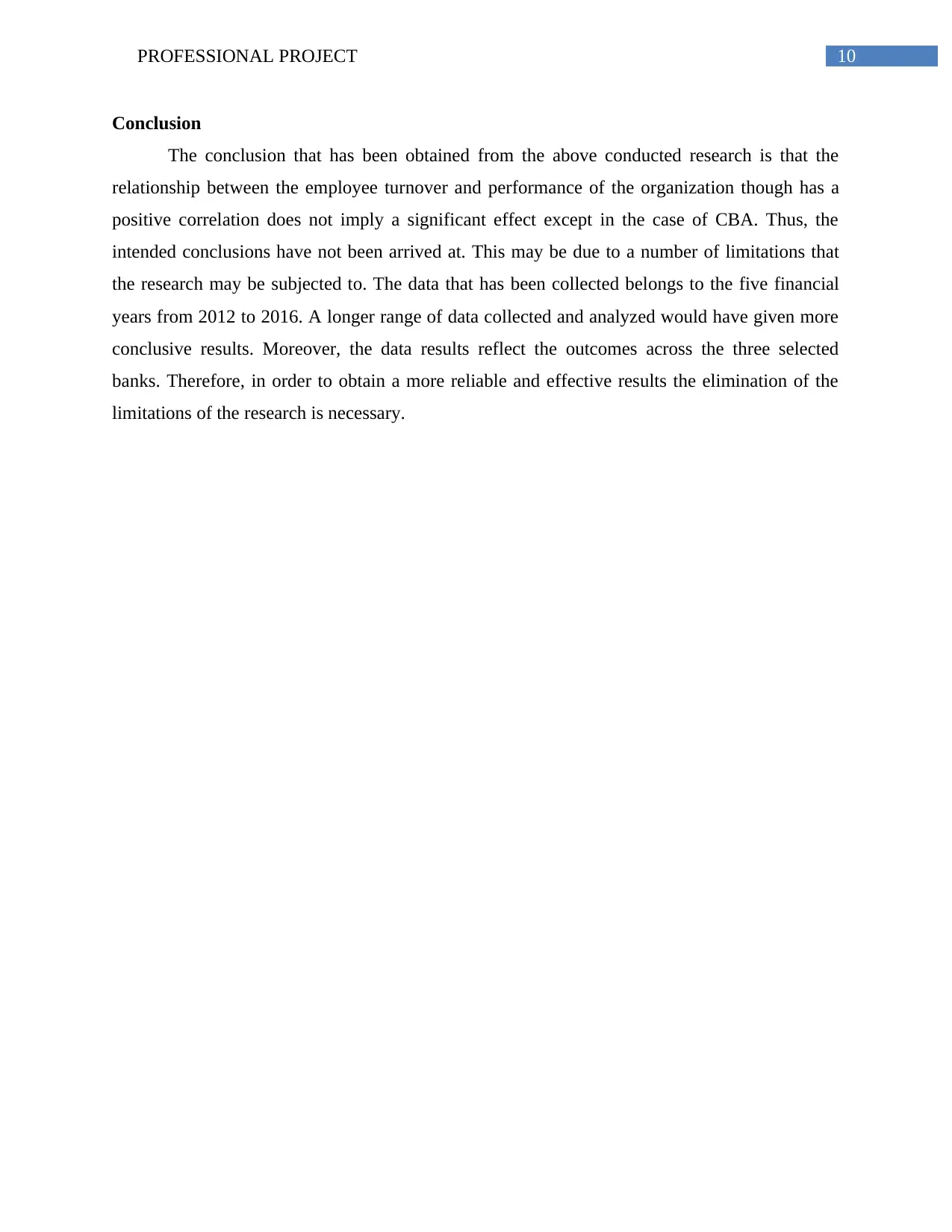
10PROFESSIONAL PROJECT
Conclusion
The conclusion that has been obtained from the above conducted research is that the
relationship between the employee turnover and performance of the organization though has a
positive correlation does not imply a significant effect except in the case of CBA. Thus, the
intended conclusions have not been arrived at. This may be due to a number of limitations that
the research may be subjected to. The data that has been collected belongs to the five financial
years from 2012 to 2016. A longer range of data collected and analyzed would have given more
conclusive results. Moreover, the data results reflect the outcomes across the three selected
banks. Therefore, in order to obtain a more reliable and effective results the elimination of the
limitations of the research is necessary.
Conclusion
The conclusion that has been obtained from the above conducted research is that the
relationship between the employee turnover and performance of the organization though has a
positive correlation does not imply a significant effect except in the case of CBA. Thus, the
intended conclusions have not been arrived at. This may be due to a number of limitations that
the research may be subjected to. The data that has been collected belongs to the five financial
years from 2012 to 2016. A longer range of data collected and analyzed would have given more
conclusive results. Moreover, the data results reflect the outcomes across the three selected
banks. Therefore, in order to obtain a more reliable and effective results the elimination of the
limitations of the research is necessary.
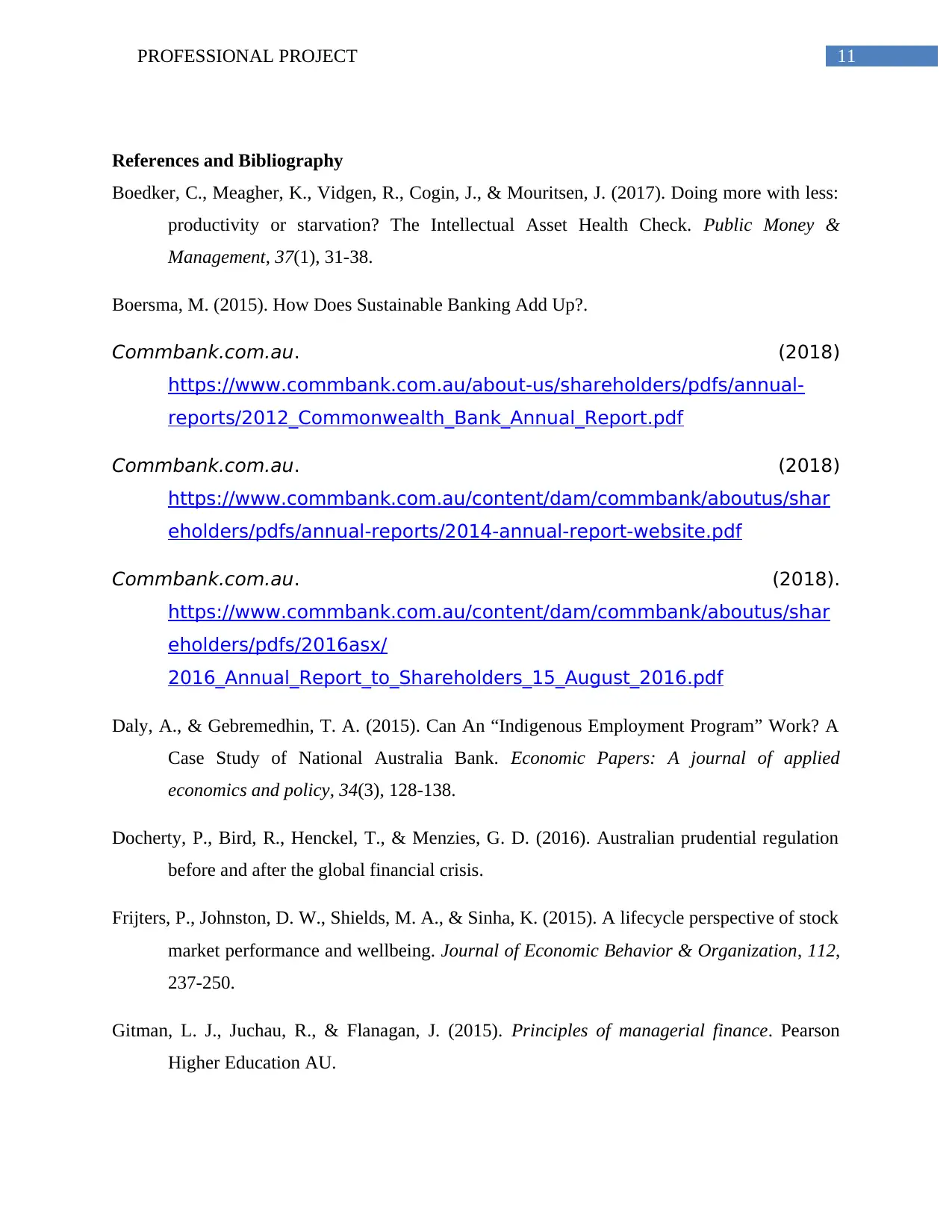
11PROFESSIONAL PROJECT
References and Bibliography
Boedker, C., Meagher, K., Vidgen, R., Cogin, J., & Mouritsen, J. (2017). Doing more with less:
productivity or starvation? The Intellectual Asset Health Check. Public Money &
Management, 37(1), 31-38.
Boersma, M. (2015). How Does Sustainable Banking Add Up?.
Commbank.com.au. (2018)
https://www.commbank.com.au/about-us/shareholders/pdfs/annual-
reports/2012_Commonwealth_Bank_Annual_Report.pdf
Commbank.com.au. (2018)
https://www.commbank.com.au/content/dam/commbank/aboutus/shar
eholders/pdfs/annual-reports/2014-annual-report-website.pdf
Commbank.com.au. (2018).
https://www.commbank.com.au/content/dam/commbank/aboutus/shar
eholders/pdfs/2016asx/
2016_Annual_Report_to_Shareholders_15_August_2016.pdf
Daly, A., & Gebremedhin, T. A. (2015). Can An “Indigenous Employment Program” Work? A
Case Study of National Australia Bank. Economic Papers: A journal of applied
economics and policy, 34(3), 128-138.
Docherty, P., Bird, R., Henckel, T., & Menzies, G. D. (2016). Australian prudential regulation
before and after the global financial crisis.
Frijters, P., Johnston, D. W., Shields, M. A., & Sinha, K. (2015). A lifecycle perspective of stock
market performance and wellbeing. Journal of Economic Behavior & Organization, 112,
237-250.
Gitman, L. J., Juchau, R., & Flanagan, J. (2015). Principles of managerial finance. Pearson
Higher Education AU.
References and Bibliography
Boedker, C., Meagher, K., Vidgen, R., Cogin, J., & Mouritsen, J. (2017). Doing more with less:
productivity or starvation? The Intellectual Asset Health Check. Public Money &
Management, 37(1), 31-38.
Boersma, M. (2015). How Does Sustainable Banking Add Up?.
Commbank.com.au. (2018)
https://www.commbank.com.au/about-us/shareholders/pdfs/annual-
reports/2012_Commonwealth_Bank_Annual_Report.pdf
Commbank.com.au. (2018)
https://www.commbank.com.au/content/dam/commbank/aboutus/shar
eholders/pdfs/annual-reports/2014-annual-report-website.pdf
Commbank.com.au. (2018).
https://www.commbank.com.au/content/dam/commbank/aboutus/shar
eholders/pdfs/2016asx/
2016_Annual_Report_to_Shareholders_15_August_2016.pdf
Daly, A., & Gebremedhin, T. A. (2015). Can An “Indigenous Employment Program” Work? A
Case Study of National Australia Bank. Economic Papers: A journal of applied
economics and policy, 34(3), 128-138.
Docherty, P., Bird, R., Henckel, T., & Menzies, G. D. (2016). Australian prudential regulation
before and after the global financial crisis.
Frijters, P., Johnston, D. W., Shields, M. A., & Sinha, K. (2015). A lifecycle perspective of stock
market performance and wellbeing. Journal of Economic Behavior & Organization, 112,
237-250.
Gitman, L. J., Juchau, R., & Flanagan, J. (2015). Principles of managerial finance. Pearson
Higher Education AU.
⊘ This is a preview!⊘
Do you want full access?
Subscribe today to unlock all pages.

Trusted by 1+ million students worldwide
1 out of 14
Related Documents
Your All-in-One AI-Powered Toolkit for Academic Success.
+13062052269
info@desklib.com
Available 24*7 on WhatsApp / Email
![[object Object]](/_next/static/media/star-bottom.7253800d.svg)
Unlock your academic potential
Copyright © 2020–2025 A2Z Services. All Rights Reserved. Developed and managed by ZUCOL.





